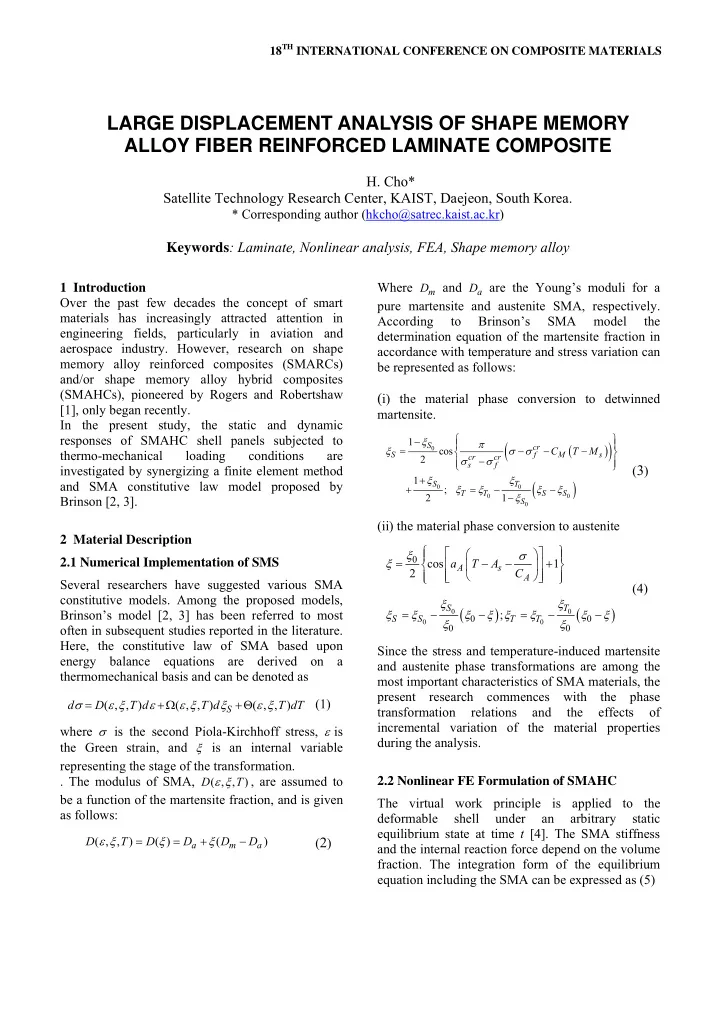

18 TH INTERNATIONAL CONFERENCE ON COMPOSITE MATERIALS LARGE DISPLACEMENT ANALYSIS OF SHAPE MEMORY ALLOY FIBER REINFORCED LAMINATE COMPOSITE H. Cho* Satellite Technology Research Center, KAIST, Daejeon, South Korea. * Corresponding author (hkcho@satrec.kaist.ac.kr) Keywords : Laminate, Nonlinear analysis, FEA, Shape memory alloy Where D and D are the Young’s moduli for a 1 Introduction m a Over the past few decades the concept of smart pure martensite and austenite SMA, respectively. materials has increasingly attracted attention in According to Brinson’s SMA model the engineering fields, particularly in aviation and determination equation of the martensite fraction in aerospace industry. However, research on shape accordance with temperature and stress variation can memory alloy reinforced composites (SMARCs) be represented as follows: and/or shape memory alloy hybrid composites (SMAHCs), pioneered by Rogers and Robertshaw ( i) the material phase conversion to detwinned [1], only began recently. martensite. In the present study, the static and dynamic responses of SMAHC shell panels subjected to 1 S cr 0 cos C T M thermo-mechanical loading conditions are S f M s cr cr 2 s f ( 3 ) investigated by synergizing a finite element method 1 and SMA constitutive law model proposed by S T 0 ; 0 T T S S 2 0 1 0 Brinson [2, 3]. S 0 (ii) the material phase conversion to austenite 2 Material Description 0 2.1 Numerical Implementation of SMS cos a T A 1 A s 2 C A Several researchers have suggested various SMA (4) constitutive models. Among the proposed models, S T 0 0 Brinson’s model [2, 3] has been referred to most ; S S 0 T T 0 0 0 often in subsequent studies reported in the literature. 0 0 Here, the constitutive law of SMA based upon Since the stress and temperature-induced martensite energy balance equations are derived on a and austenite phase transformations are among the thermomechanical basis and can be denoted as most important characteristics of SMA materials, the present research commences with the phase (1) d D ( , , ) T d ( , , ) T d ( , , ) T dT S transformation relations and the effects of incremental variation of the material properties where is the second Piola-Kirchhoff stress, is during the analysis. the Green strain, and is an internal variable representing the stage of the transformation. . The modulus of SMA, , are assumed to D ( , , ) T 2.2 Nonlinear FE Formulation of SMAHC be a function of the martensite fraction, and is given The virtual work principle is applied to the as follows: deformable shell under an arbitrary static equilibrium state at time t [4]. The SMA stiffness D ( , , ) T D ( ) D ( D D ) ( 2 ) a m a and the internal reaction force depend on the volume fraction. The integration form of the equilibrium equation including the SMA can be expressed as (5)
vary according to temperature change; however, in 0 t 0 C e e dV S dV the present analysis, it is assumed that the material 0 ijrs 0 rs 0 ij 0 ij 0 ij 0 0 V V properties of the graphite/epoxy ply are constant 0 H C f f e e dV 0 ijrs 0 ij 0 rs 0 ij 0 rs regardless of any increase or decrease of temperature. 0 V (5) t 0 t t t th 0 S e dV R e dV 0 ij 0 rs 0 0 ij 0 0 Table 2. Material properties of the SMA V V t sma 0 t 0 e dV S e dV Value 0 0 ij 0 ij 0 ij 0 0 V V Properties Coefficients of D =67.0GPa constitutive equation a 3 Example Problem of SMAHC Subjected to D =26.3Gpa m Structural and Thermal Loading =0.55MPa =6448.1kg/m 3 The suggested description can be verified through an Density example problem. The dimensions of the analyzed Recovery strain =0.067 plate are 240mm by 160mm rectangular laminate, limit L whereas the thickness is 2mm, including the top Four phase SMA/epoxy layer. Clamped boundary conditions are M =9.0 ℃ transformation f applied to the left edge of the plate. temperature Fig. 1 illustrates the configuration of a modeled M =18.4 ℃ s element consisting of five layers. A =34.5 ℃ The orientation angle of the SMA wires within the s A =49.0 ℃ SMA/epoxy layers maintains zero degrees, f measured in a counter-clock wire direction from the Transition stiffness C =8.0MPa/ ℃ positive x-axis. The relative volume fraction of the (stress/temperature) M SMA wires within the top layer of the plate is 0.2. C =13.8MPa/ ℃ A All SMA wire properties and graphite/epoxy Critical =100MPa cr composite are summarized and presented in Tables 1 transformation stress s and 2. =170MPa cr f =11e-6/ ℃ Thermal expansion Table 1. Material properties of Gr/E. A =6.6e-6/ ℃ M Properties Graphite Epoxy (Gr/E) E 11 138 GPa E 22 = E 33 8.28 GPa υ 12 = υ 13 0.33 υ 23 0.37 G 12 = G 13 6.9 GPa G 23 3.6GPa ρ 1600 kg/m3 0.18e-6/ ℃ 1 = 27.0e-6/ ℃ 2 3 Fig.1. Geometry configuration of the SMAHC plate. The purpose of this analysis is to quantifiably verify the effects of SMA wires embedded in a laminated Note that this is not for SMAs. Consequently, the code can more clearly represent the effects of SMA composite on the responses of static and dynamic behaviors upon thermomechanical loadings. For this, reinforced lamina with respect to a general two different layups are compared, a pure Gr/E composite. A total of four cases were analyzed and the results layup and a hybrid SMA/E and Gr/E layup. In reality, the material properties of the graphite/epoxy compared: case I: [0/0/0/0/0] Gr/E , [(SMA/epoxy)/0/0/0/0] hybrid ; case II: [30/-30/30/-
Recommend
More recommend